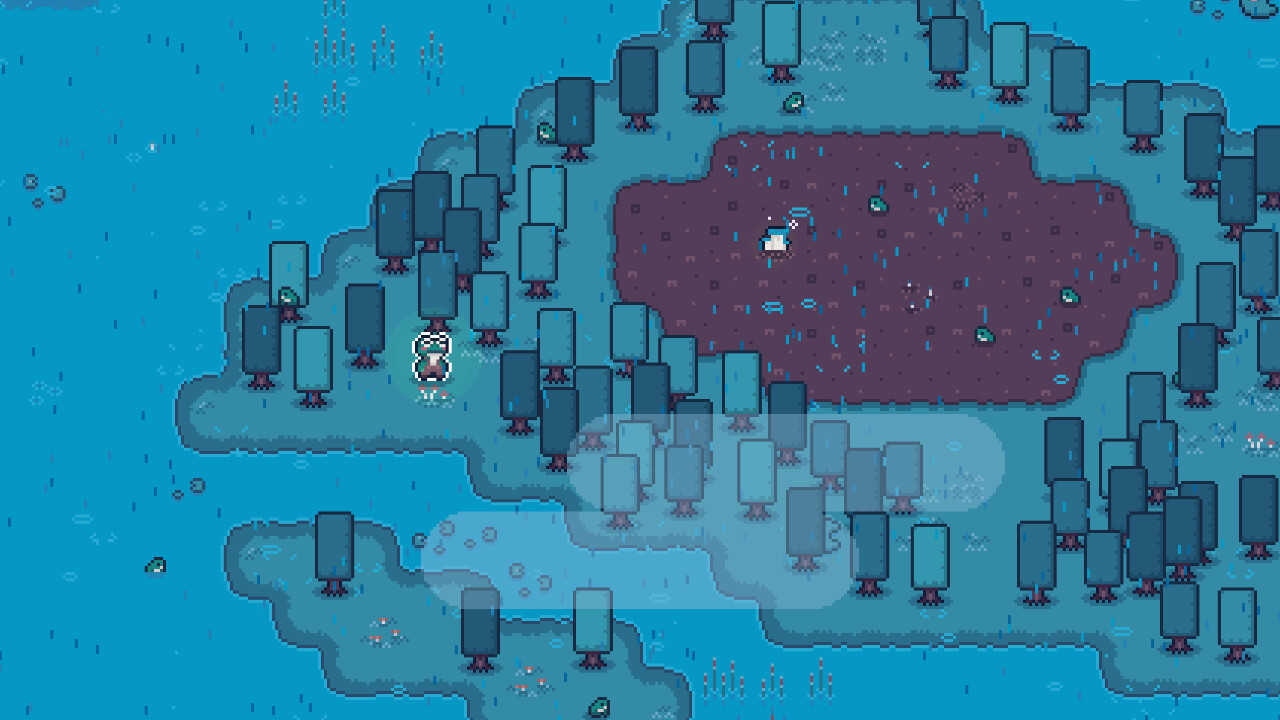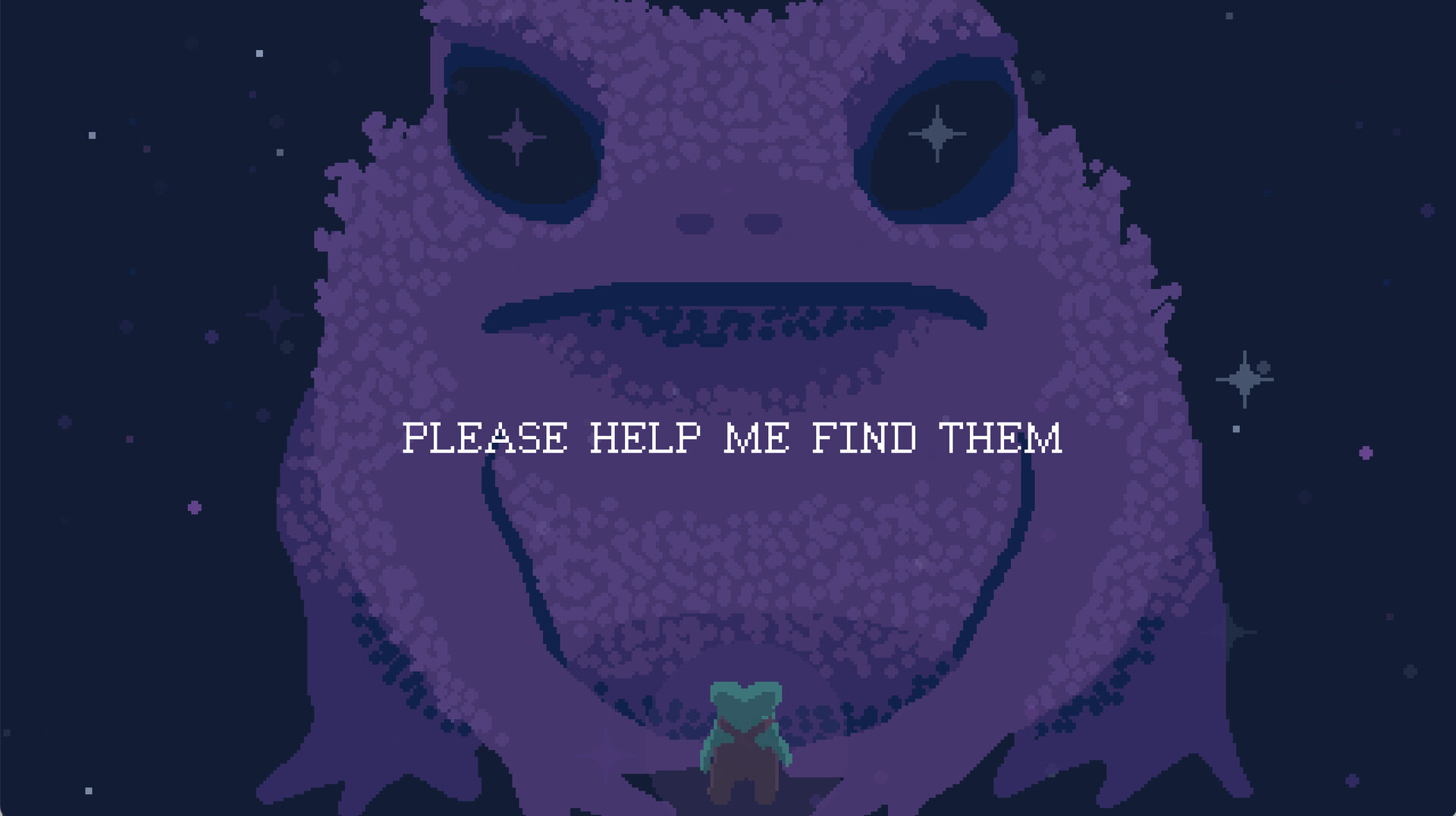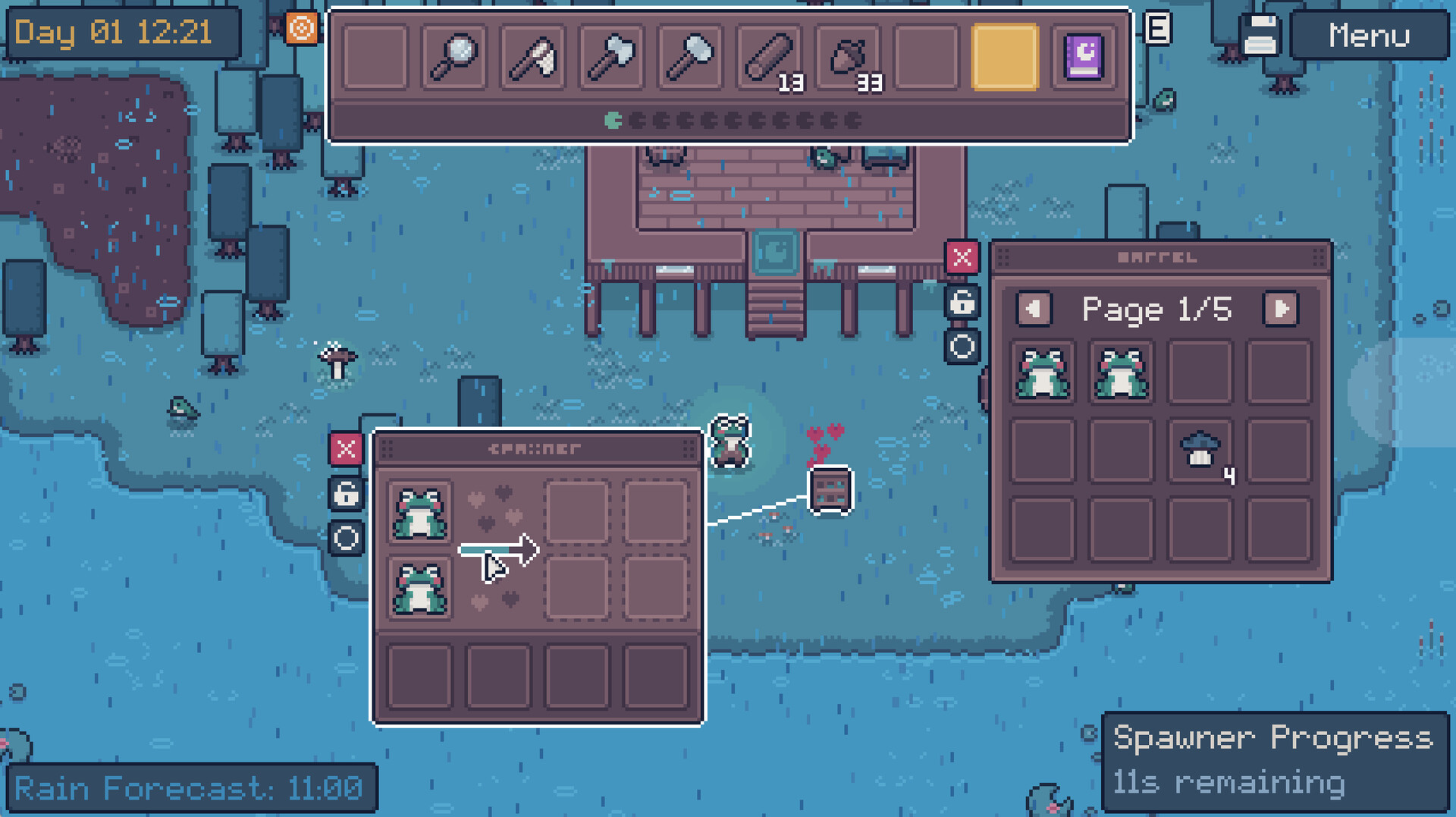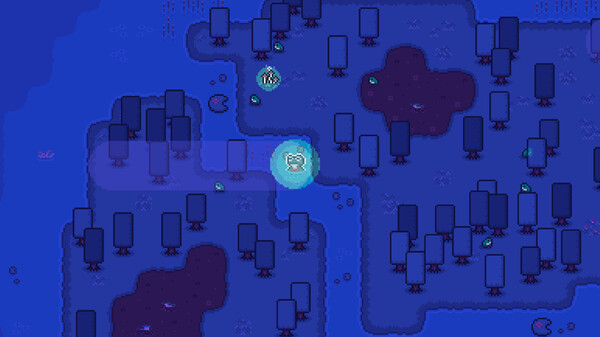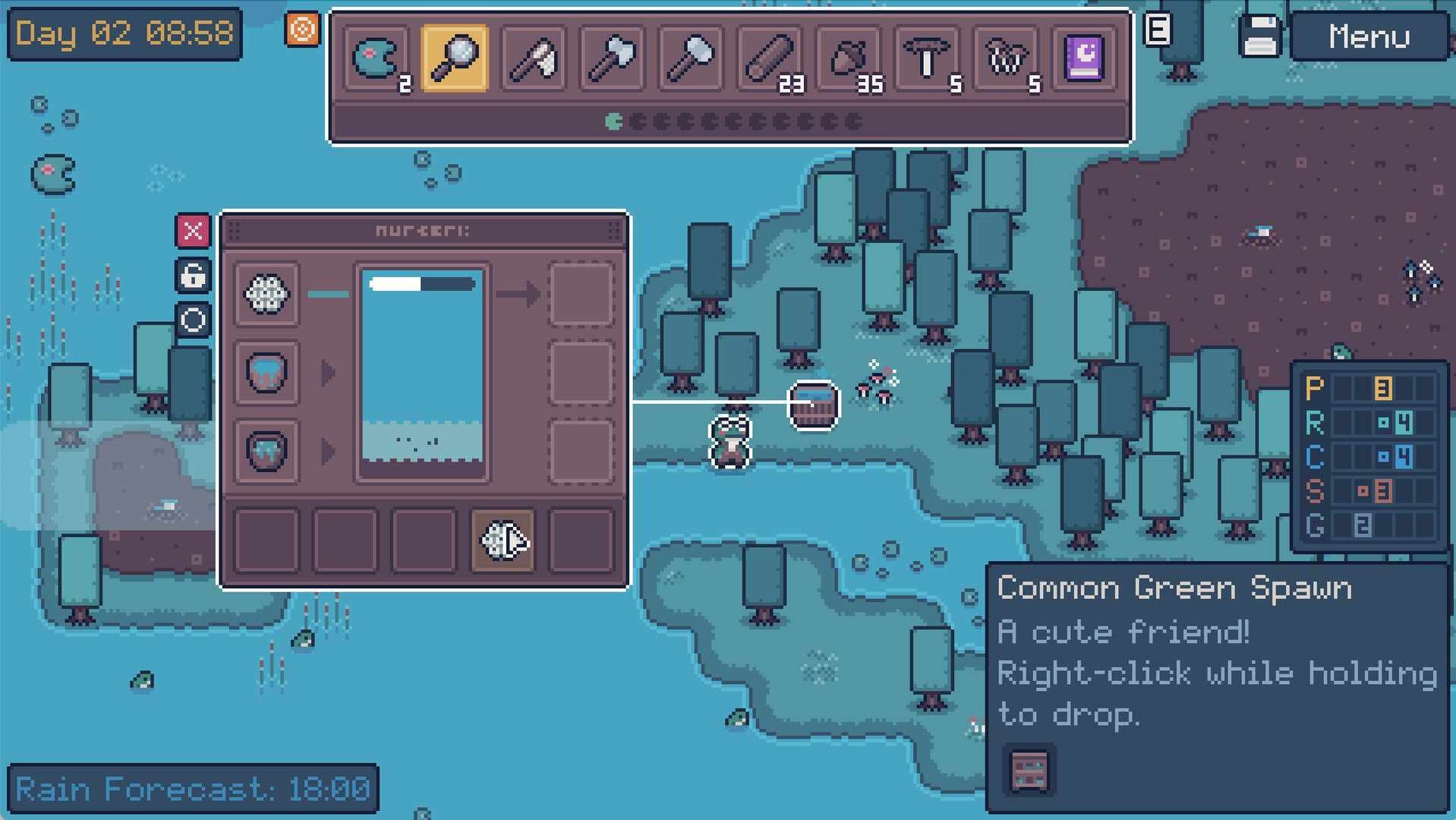

MUDBORNE... YOU HAVE BEEN CHOSEN
Mudborne is a laid-back nature sim game about breeding & collecting frogs! Visited in your dreams by a mysterious deity, you begin a journey to help rediscover Her lost children.

- Finally reach your life goals and become an actual frog!
- TINY LITTLE FROGS YOU CAN CATCH AND CHASE
- Find and collect different mushrooms to help buff (or debuff) your frogs
- Play god and manipulate your frogs genetics to find new species
- One of the frogs has a tiny hat!!! GOTY contender????

Mudborne spawned as a small week-long gamejam, #FletchFest, organised by FletchMakes!
The result is the game you can play for free over on https://tngineers.itch.io/mudborne, with music by Mothense! :D
I've always joked about making "APICO but frog", but it's never been much more than that - with the gamejam theme of "pond" however it seemed like a good opportunity to make it a reality!
With Mudborne I wanted to play more with the idea of direct manipulation & min/max-ing of genetics to find new species (rather than just slapping bees together), as well as some more interesting nature mechanics - while still bringing the same menu management & crafting minigame vibes you all know and love (along with all the learning I've had making APICO!)
I've got lots of ideas for this concept and would love to turn this into a more fleshed out demo and maybe even a full game if people are interested, so if you are maybe give it a lil wishlist??

If you want to follow along with the project you can catch us on Twitter, or hit up the TNgineers Discord, links are in the sidebar.
Devlog #6 - Garden Variety

Originally when doing the overworld design I didn't think much more than what the waking vs dream world, but now I knew roughly the size of the world and the areas in it I knew I couldn't get away with just using the same "biome" style throughout the game - sure I could do a few different flora/fauna and setpieces to match the utility of that area in-game, but I wanted to make each of the regions more unique and interesting.
I went through a lot of different styles before settling, here's a few of them!
1. Initial idea, blue/greens for waking and then more vibrant for the dream
2. More detailed flora + grass that you can see in the first two green areas, can also start to see more interesting tree designs + stone decoration for the islands
3. Settling on the third "residential" area and the dream counterparts for the first three regions, plus starting to narrow down the snowy + central region styles
4. The current designs, with the first 4 regions implemented while I still tinker with the final central region
Lots of the color changes were tweaked slightly over time too - the first concept was drawn towards the start of september, the fourth one is what is currently used in-game (although still working on the 5th one)

The main thing I wanted was to have lots of variety and interesting plants and flora to make each region feel more unique outside of just palette changes - some areas also go a step further with some larger unique stuff, like the algae in the swamps or the flooded rooms in the residential district.

As I was designing them I changed the grass style to be an actual texture - darker blades that are part of the tiles themselves, and then lighter blades that I actually individually place.
I think this was a nice middle ground as I can get some unique grass patterns that are not tiled and dont look too repetitive. I also added a lot more stone tile decoration stuff, like the bricks or the vines - just to help make those sections more interesting as in contrast to the water they were very flat and empty.
For comparison this is what the demo had for a standards building:
And here is a normal building in the full game with the newer designs:
It's a bit more work to create the levels now as I have a lot more stuff to place manually - but I think the end result is worth it and let's me have much more interesting and pretty areas to explore, which is important for a game where I want players to explore and find all the secrets.
[hr][/hr]
As it stands in the demo you farm mushrooms, each with a special effect to modify traits. You can then combine 3 of these together into 1 "magic mud" to modify your frogspawn.

With hybrid mushrooms the idea is that you can combine any two standard mushrooms together to make 1 mushroom with the effects of both - this means you could have up to 6 modifications within one generation!
To do this you collect spores from either natural spawns or your farms, and then you make 'prints' of the spores to paper, which lets you print two different mushrooms to the same piece of spore paper.

You can then use this paper in your farms - so instead of waiting for spores to form naturally you can just set the spores you want. You wouldn't even need to use a hybrid spore paper for this either, so it's a bit more control on exactly the spores you're farming.
Once the mushrooms bloom (as hybrids either mushroom's conditions can be met), you gather them as normal and grind them into powder as normal - but they are now a hybrid mushroom/powder with both effects applying to them when used.

This will get a bit complex, but it will be useful for a bunch of reasons - you can counteract 'bad' modifications you don't want into one mushroom, you can do more changes quickly in less generations, and then the main reason to solve more complex genetic puzzles.
It also gives the player a lot more options to approach making a genetic key, as there will be more than 1 'correct' answer or combination to meet the trait changes required across generations.
[hr][/hr]

This is the region where frogspawn+tadpoles are raised at the pond, as well as where mushrooms and bugs are farmed for resources and food.
Because of that the gameplay focus of this area is on learning about hybrid mushrooms, getting some better farming options, and upgrading the bug collection mechanics to make it easier to get bugs en-masse - like the bug traps that let you use extra-stinky frogs to attract and catch bugs automatically while you're away.

It also introduces the first overworld "obstacle" (not counting the puzzles like the gates or the pressure pads or lilypads) - algae blooms.

These deadly blooms can't be crossed, so you need to clear them. Luckily you have a whole hoard of frogs at your disposal, and by boosting the "Edacity" trait you can make some very hungry frogs that'll eat anything not nailed down.
Placing them in filters will slowly clear the algae nearby and let you pass through to the areas they're blocking off.

When you come to this region you'll get to learn about how to handle algae and given the tools to clear it - but you would of already come across some smaller blooms in other regions. So once you have the machines and the frogs from this region you can go back and explore those other areas.
I also wanted some stagnant water pools to this area as it seemed fitting with the theme that certain areas would be blocked off to make stagnant pools for certain bugs or flora to grow in - not entirely sure what I'll use these for yet but it's nice to have some stuff open ended for when I come to the actual real world design and playtesting to tie everything together.

While testing all of this I've been using a "dev" map - which is just a bunch of different regions slapped together each with a mini-island.

It's helping me visualise the look+feel of each region and means I've already implemented the gruntwork for adding that region - when it comes to designing the map of the full game I won't have to do much more work outside of just creating the areas, the rest is ready to go.
[hr][/hr]
This is taken to extremes in this region, as you will get the ability to make a 1S frog that is so dry it absorbs water, and a 7S frog that is so wet is seemingly makes more water. Together this frogs can be used with a Dehumidifer + a Hydrator to effect the nearby environment.

This is hinted at in the demo with the standard cultivators - that there'll be mushrooms that require the extremes of moisture and temperature, and this is the first region to cover those extremes.
Using these machines lets you make the environment a lot wetter and dryer than it should be - for example making extremely damp indoors regions, or extremely dry water (has science gone too far?).

An even more extreme use of this trait comes in with "croakwork" machines - automated machines powered by the sound of frogs, created by the Engineer. The first of these machines is the Drainer - a powerful croakwork machine that uses minimum saturation frogs to drain the flooded rooms of the residential district.

You can enter these rooms at first, however you can't interact with any of the flooded objects until you drain the room - revealing the objects plus anything else that might have been hiding under the water...
By draining the rooms you're helping to restore the region ready for the hibernating frogs to return, as well as uncovering some pathways to get around the area and find other secret places or basements.

Other croakwork machines introduced here include the "Masher" - an automated grinder upgrade, and the "Harvester" - an automated machine that will harvest nearby blooming mushrooms and renewables automatically.

There's not a lot in Mudborne that needs to be automated, so there's not too many machines, but there's a few that should be useful and as I play more I'll be able to spot any processes that might need an upgrade that can be added to the Engineer's stock.
[hr][/hr]
These will go alongside a whole host of decorative items and furniture to allow you to make any area you're own.

I tried to give both the wooded flooring and wooden piers a bit more interesting textures to them too rather than being perfect repetitive planks, as the original texture (ripped from APICO) no longer matched with all the new design stuff I'd done with the environment.

I had to do some messing around with the flora in the water and the new grass, as due to how I render the order of certain things the flora would be on top - so when placing tiles you temporarily disable any flora underneath so it's not causing issues.
This is similar to how the algae disables any plants underneath it, meaning that you can't get bugs or mushrooms on any areas of water covered in algae - and also what I'd use with ice to decide whether to show a frozen/snow covered variant of the sprite instead of the default one.
[hr][/hr]
This is where the residents of the research pool store their food and genetic materials, using the cold to keep things preserved. This area introduces temperature extremes (hot+cold), as well as ice that can be thawed out - or created to allow you to cross deeper water by freezing it.

I've only just now started to get the region loaded into the game - there was a lot of design stuff I was doing first. However now it's here I can work on the new machines that utilise the temperature and let you freeze water or melt ice. There'll be other things to unfreeze too - frogs, gates, and NPC...

As it's the region themed around storage you'll also get a whole bunch of new storage themed upgrades and advancements, like a big box to store all your frogs and search them easily, or an upgraded cauldron that can store all of your powders inside.
[hr][/hr]
While doing all of this there was a few other odd bits and bobs I was working on, like polyps which are growable jellyfish for the dream world - or huge mangroves which will have a special use in the dream.

I was hoping to have done all the mechanics this month and implement them all, but I ended up not getting through them because I was sidetracked by adding the actual regions themselves - I didn't need to for most of the mechanics (and even flooding/ice I could of tested without the region itself), but I think it helped me see how the region would look and tweak things with the mechanics to fit better into the world that I wouldn't of done otherwise.
Over October I'll be finishing up the cold region and the central region, and getting through the last lot of machines to implement (orange, purple and brown sections below)

With that done I'll then be able to leave the developer map behind and start designing the actual world itself - which is going to be most of the game development time I think!
~ Ell
Hey friends! The last month I was able to work on Mudborne pretty much full-time, so I got a whole lot designed and implemented - let's get into it all.
[hr][/hr]
Biodiversity
After finishing the designs for all of the mechanics, I also spent some time trying to design how each of the 5 main regions would look and feel.
Originally when doing the overworld design I didn't think much more than what the waking vs dream world, but now I knew roughly the size of the world and the areas in it I knew I couldn't get away with just using the same "biome" style throughout the game - sure I could do a few different flora/fauna and setpieces to match the utility of that area in-game, but I wanted to make each of the regions more unique and interesting.
I went through a lot of different styles before settling, here's a few of them!
1. Initial idea, blue/greens for waking and then more vibrant for the dream

2. More detailed flora + grass that you can see in the first two green areas, can also start to see more interesting tree designs + stone decoration for the islands

3. Settling on the third "residential" area and the dream counterparts for the first three regions, plus starting to narrow down the snowy + central region styles

4. The current designs, with the first 4 regions implemented while I still tinker with the final central region

Lots of the color changes were tweaked slightly over time too - the first concept was drawn towards the start of september, the fourth one is what is currently used in-game (although still working on the 5th one)

The main thing I wanted was to have lots of variety and interesting plants and flora to make each region feel more unique outside of just palette changes - some areas also go a step further with some larger unique stuff, like the algae in the swamps or the flooded rooms in the residential district.

As I was designing them I changed the grass style to be an actual texture - darker blades that are part of the tiles themselves, and then lighter blades that I actually individually place.
I think this was a nice middle ground as I can get some unique grass patterns that are not tiled and dont look too repetitive. I also added a lot more stone tile decoration stuff, like the bricks or the vines - just to help make those sections more interesting as in contrast to the water they were very flat and empty.
For comparison this is what the demo had for a standards building:

And here is a normal building in the full game with the newer designs:

It's a bit more work to create the levels now as I have a lot more stuff to place manually - but I think the end result is worth it and let's me have much more interesting and pretty areas to explore, which is important for a game where I want players to explore and find all the secrets.
[hr][/hr]
Spore Printing
While working on and off on the actual world style, I started to work on implementing some of the new mechanics for the full game - the main one not really covered by the demo in any way is spore printing and hybrid mushrooms.As it stands in the demo you farm mushrooms, each with a special effect to modify traits. You can then combine 3 of these together into 1 "magic mud" to modify your frogspawn.

With hybrid mushrooms the idea is that you can combine any two standard mushrooms together to make 1 mushroom with the effects of both - this means you could have up to 6 modifications within one generation!
To do this you collect spores from either natural spawns or your farms, and then you make 'prints' of the spores to paper, which lets you print two different mushrooms to the same piece of spore paper.

You can then use this paper in your farms - so instead of waiting for spores to form naturally you can just set the spores you want. You wouldn't even need to use a hybrid spore paper for this either, so it's a bit more control on exactly the spores you're farming.
Once the mushrooms bloom (as hybrids either mushroom's conditions can be met), you gather them as normal and grind them into powder as normal - but they are now a hybrid mushroom/powder with both effects applying to them when used.

This will get a bit complex, but it will be useful for a bunch of reasons - you can counteract 'bad' modifications you don't want into one mushroom, you can do more changes quickly in less generations, and then the main reason to solve more complex genetic puzzles.
It also gives the player a lot more options to approach making a genetic key, as there will be more than 1 'correct' answer or combination to meet the trait changes required across generations.
[hr][/hr]
The Kindergarten
In the demo you're just in an area based off the 'Spawning Pools'. In the full-game, after leaving this area to a central hub region, one of the first main regions you can go to is the Kindergarten.
This is the region where frogspawn+tadpoles are raised at the pond, as well as where mushrooms and bugs are farmed for resources and food.
Because of that the gameplay focus of this area is on learning about hybrid mushrooms, getting some better farming options, and upgrading the bug collection mechanics to make it easier to get bugs en-masse - like the bug traps that let you use extra-stinky frogs to attract and catch bugs automatically while you're away.

It also introduces the first overworld "obstacle" (not counting the puzzles like the gates or the pressure pads or lilypads) - algae blooms.

These deadly blooms can't be crossed, so you need to clear them. Luckily you have a whole hoard of frogs at your disposal, and by boosting the "Edacity" trait you can make some very hungry frogs that'll eat anything not nailed down.
Placing them in filters will slowly clear the algae nearby and let you pass through to the areas they're blocking off.

When you come to this region you'll get to learn about how to handle algae and given the tools to clear it - but you would of already come across some smaller blooms in other regions. So once you have the machines and the frogs from this region you can go back and explore those other areas.
I also wanted some stagnant water pools to this area as it seemed fitting with the theme that certain areas would be blocked off to make stagnant pools for certain bugs or flora to grow in - not entirely sure what I'll use these for yet but it's nice to have some stuff open ended for when I come to the actual real world design and playtesting to tie everything together.

While testing all of this I've been using a "dev" map - which is just a bunch of different regions slapped together each with a mini-island.

It's helping me visualise the look+feel of each region and means I've already implemented the gruntwork for adding that region - when it comes to designing the map of the full game I won't have to do much more work outside of just creating the areas, the rest is ready to go.
[hr][/hr]
Residential District
Moving onto the next main area, the residential district - this focus on two main things, Saturation, and Croakwork. Saturation is one of the frog traits, the higher the trait the wetter the frog, the lower the trait the dryer the frog.This is taken to extremes in this region, as you will get the ability to make a 1S frog that is so dry it absorbs water, and a 7S frog that is so wet is seemingly makes more water. Together this frogs can be used with a Dehumidifer + a Hydrator to effect the nearby environment.

This is hinted at in the demo with the standard cultivators - that there'll be mushrooms that require the extremes of moisture and temperature, and this is the first region to cover those extremes.
Using these machines lets you make the environment a lot wetter and dryer than it should be - for example making extremely damp indoors regions, or extremely dry water (has science gone too far?).

An even more extreme use of this trait comes in with "croakwork" machines - automated machines powered by the sound of frogs, created by the Engineer. The first of these machines is the Drainer - a powerful croakwork machine that uses minimum saturation frogs to drain the flooded rooms of the residential district.

You can enter these rooms at first, however you can't interact with any of the flooded objects until you drain the room - revealing the objects plus anything else that might have been hiding under the water...
By draining the rooms you're helping to restore the region ready for the hibernating frogs to return, as well as uncovering some pathways to get around the area and find other secret places or basements.

Other croakwork machines introduced here include the "Masher" - an automated grinder upgrade, and the "Harvester" - an automated machine that will harvest nearby blooming mushrooms and renewables automatically.

There's not a lot in Mudborne that needs to be automated, so there's not too many machines, but there's a few that should be useful and as I play more I'll be able to spot any processes that might need an upgrade that can be added to the Engineer's stock.
[hr][/hr]
Fancy Flooring
While implementing these two regions I was also messing around with some flooring designs. Both the algae and the flooded room water are types of flooring, so I was already having to implement that system and the auto-tiling stuff, so it was easy enough to then start adding more decorative flooring.These will go alongside a whole host of decorative items and furniture to allow you to make any area you're own.

I tried to give both the wooded flooring and wooden piers a bit more interesting textures to them too rather than being perfect repetitive planks, as the original texture (ripped from APICO) no longer matched with all the new design stuff I'd done with the environment.

I had to do some messing around with the flora in the water and the new grass, as due to how I render the order of certain things the flora would be on top - so when placing tiles you temporarily disable any flora underneath so it's not causing issues.
This is similar to how the algae disables any plants underneath it, meaning that you can't get bugs or mushrooms on any areas of water covered in algae - and also what I'd use with ice to decide whether to show a frozen/snow covered variant of the sprite instead of the default one.
[hr][/hr]
Ice Frog Cometh
After finishing up those two areas and all the mechanics in them, towards the end of this month I started working on the icy region, Cold Storage.This is where the residents of the research pool store their food and genetic materials, using the cold to keep things preserved. This area introduces temperature extremes (hot+cold), as well as ice that can be thawed out - or created to allow you to cross deeper water by freezing it.

I've only just now started to get the region loaded into the game - there was a lot of design stuff I was doing first. However now it's here I can work on the new machines that utilise the temperature and let you freeze water or melt ice. There'll be other things to unfreeze too - frogs, gates, and NPC...

As it's the region themed around storage you'll also get a whole bunch of new storage themed upgrades and advancements, like a big box to store all your frogs and search them easily, or an upgraded cauldron that can store all of your powders inside.
[hr][/hr]
While doing all of this there was a few other odd bits and bobs I was working on, like polyps which are growable jellyfish for the dream world - or huge mangroves which will have a special use in the dream.

I was hoping to have done all the mechanics this month and implement them all, but I ended up not getting through them because I was sidetracked by adding the actual regions themselves - I didn't need to for most of the mechanics (and even flooding/ice I could of tested without the region itself), but I think it helped me see how the region would look and tweak things with the mechanics to fit better into the world that I wouldn't of done otherwise.
Over October I'll be finishing up the cold region and the central region, and getting through the last lot of machines to implement (orange, purple and brown sections below)

With that done I'll then be able to leave the developer map behind and start designing the actual world itself - which is going to be most of the game development time I think!
~ Ell
[ 2024-09-30 15:10:08 CET ] [Original Post]
Minimum Setup
- OS: Ubuntu 20.04 LTS
- Processor: Intel Core i5 (4th Gen)Memory: 4 MB RAM
- Memory: 4 MB RAM
- Graphics: Intel HD Integrated
- Storage: 250 MB available space
GAMEBILLET
[ 6469 ]
GAMERSGATE
[ 2503 ]
MacGamestore
[ 1972 ]
FANATICAL BUNDLES
HUMBLE BUNDLES
by buying games/dlcs from affiliate links you are supporting tuxDB

